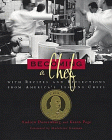
1916 Bakery Company
[Organization] [Duties of Personnel] [Equipment]
According to 1916 edition of the Manual for Army Bakers, the bakery company baked bread for the troops in the field and in garrison. Since the bread ration in 1916 consisted of 18 ounces per man, the company could produce almost 34,000 pounds of garrison bread each day.
In wartime, companies were established at the rate of one per Army division. However, they were not considered as an organic organization within the division. As a unit of the Quartermaster Corps, bakery companies reported to the commander of the line of communications. One or more companies could be located at a permanent or semi-permanent camp to provide bread for nearby troops. If needed, a company could be divided into sections or units to bake bread for smaller troop concentrations.
In peacetime service, the companies were assigned to the territorial departments in the interior. Sections and units were dispersed among smaller bases as necessary.
The bakery company was organized as follows:
Company -- Consisted on one Quartermaster Corps officer and 101 Quartermaster Corps soldiers. The company could supply bread for division of 30,000 troops (33,750 pounds of garrison bread per day). Each company was organized into five sections.
Section -- Consisted of one Quartermaster Corps sergeant and 18 Quartermaster Corps bakers. The section could supply bread for 6,000 troops (6,750 pounds of garrison bread per day). Each section was organized into three sections, which were lettered A through E.
Unit -- Consisted of one Quartermaster Corps sergeant and five Quartermaster Corps bakers. The unit could supply bread for 2,000 troops (2,250 pounds of garrison bread per day). The unit was the smallest organizational element of the company, which were numbered 1 through 15. Each unit operated one oven (Army Field Bake Oven No. 1).
| Table of Organization for 1916 Bakery Company | |||
|---|---|---|---|
| Description | Unit | Sec- tion |
Com- pany |
| Commissioned officer | -- | -- | 1 |
| Enlisted personnel: | === | === | === |
| Chief baker -- quartermaster sergeant, Quartermaster Corps (acting first sergeant) | --- | --- | 1 |
| Assistant chief bakers -- sergeants, Quartermaster Corps (1 in charge of each section) | --- | 1 | 3 |
| Mess sergeant -- sergeant, Quartermaster Corps | --- | --- | 1 |
| Supply sergeant and artificer -- sergeant, Quartermaster Corps | --- | --- | 1 |
| Company clerk -- sergeant, Quartermaster Corps | --- | --- | 1 |
| Bakers -- sergeants, Quartermaster Corps (1 in charge of each unit) | 1 | 3 | 15 |
| Assistant bakers -- corporals, Quartermaster Corps (1 to each unit) | 1 | 3 | 15 |
| Assistant bakers -- privates, first class, Quartermaster Corps (3 to each unit) | 3 | 9 | 45 |
| Apprentices -- privates, Quartermaster Corps (3 to each unit) | 1 | 3 | 15 |
| Cooks -- Quartermaster Corps | --- | --- | 2 |
| Total enlisted personnel | 6 | 19 | 101 |
Excerpts are quoted from pages 75 and 76 of the Manual for Army Bakers.
Officer in charge
"The officer in charge is responsible for the training and discipline of the personnel. He is responsible and accountable for the field bakery. He can consider his mission accomplished only when the troops are promptly supplied with good bread, both in camp and on the march. When the division is demobilized, he is stationed at the headquarters of the company as assistant to the post quartermaster."
Chief baker (first sergeant and quartermaster sergeant)
"The chief baker, under the officer in charge, has general supervision of the bakery company and field bakery. He acts as first sergeant and as quartermaster sergeant of the company, keeps the company records, keeps records of subsistence stores received and expended in making, makes issues to organizations, prepares bread-count statement on the last day of the month. He sees that the units are properly manned, replaces absent and sick bakers from the supernumerary bakers. He assigns bread store tents to the sections, keeps the keys to the store tents, and makes all issues of baking supplies. He is stationed at the headquarters of the bakery company."
Chief of section (assistant chief baker)
"The chief of section is directly responsible for the efficiency, cleanliness, and appearance of his section, both personnel and material. He is responsible that the firing is properly done, bread baked properly, and that the bread produced is up to proper standard. He inspects each run of bread after it is baked and before it is put in storage. He takes general charge of his section in making and breaking camp, and is responsible that the equipment and wagons are properly packed. He draws daily from the chief baker the supplies required for his section and issues them to the chiefs of units. He submits a daily report of the amount of bread to the chief baker at the close of work. He takes care that the water used in making doughs is of proper temperature to give the average for flour, tent and water, of 240o F. (243 in summer, 246 in winter). After the completion of the day's baking he sees that the mixing tents, utensils, ovens, and grounds are in good police. In wet weather, he sees that wood for the first fire for the next day's run is put in a dry place.
"When two or more sections are operating together, a chief of section takes entire charge of all sections of the bakery during the tour of duty of one shift."
Chief of unit (baker)
"The chief of unit is responsible to the chief of section for the efficiency, cleanliness, and appearance of his unit. He is responsible for the quality and condition of the bread of his unit. He is responsible to the chief of section for the property of the unit."
Each bakery unit required the following equipment to bake bread:
| Table of Equipment for One Bakery Unit | |
|---|---|
| Articles | Units |
| Axe | 1 |
| Boards, dam for dough troughs | 2 |
| Burner, oil, complete | 1 |
| Brush, bench | 1 |
| Brush for greasing loaves | 1 |
| Buckets, galvanized iron | 3 |
| Cans, sponge, nested | 7 |
| Clock, alarm | 1 |
| Colander, 12-inch | 1 |
| Covers, canvas, for dough troughs | 2 |
| Covers, canvas, for bread racks | 3 |
| Cover, canvas, for oven | 1 |
| Cover for sponge can | 1 |
| Extra burner and feed wire without tank | 1 |
| Hatchet | 1 |
| Hose, fire | 1 |
| Hook, pan | 1 |
| Lamps, acetylene | 2 |
| Measure, gallon, graduated, cast aluminum | 1 |
| Oven, field | 1 |
| Pans, bake, 12 by 24 inches | 36 |
| Paulins, large and small, in number required | --- |
| Pickaxe, with handle | 1 |
| Racks, bread, folding | 3 |
| Rake | 1 |
| Scale | 1 |
| Scoop, cast aluminum | 1 |
| Scrapers, dough | 2 |
| Shovel, long handle | 1 |
| Sieve, flour, 13-inch | 1 |
| Stove, Sibley, complete | 1 |
| Table, molding | 1 |
| Tent, wall, large, open at both ends | 1 |
| Tent, pyramidal, large | 1 |
| Thermometer, oven | 1 |
| Troughs, dough | 2 |
| Wrench, monkey, 8-inch | 1 |
| Wrench, Stillson, 10-inch | 1 |
It is interesting to note that the Quartermaster Corps made few changes to the equipment allowance for one bakery unit in World War II.
The allowance for each section consisted of the equipment for three bakery units and the following additional equipment:
| Table of Additional Equipment for One Bakery Section | |
|---|---|
| Articles | Units |
| Fly, tent, wall, small | 1 |
| Funnel, 6-inch | 1 |
| Tents, storage | 2 |
The allowance for company headquarters consisted of the following equipment:
| Table of Equipment for Company Headquarters | |
|---|---|
| Articles | Units |
| Chest, tool, company | 1 |
| Desk, field | 1 |
| Pennant | 1 |
| Ranges, No. 1, complete | 3 |
| Screens, latrine | 2 |
| Tents, wall, small | 3 |
Return to Bread Baking in World War I Army
Bibliography
Deitrck, Capt. L.L., ed. Manual for Army Bakers. War Dept. Doc. 563. Washington: GPO, 1916. 123pp.
| Bulletin Board | Keyword Search |
| Bookstore | Links |
| About Us | Recent Additions |

